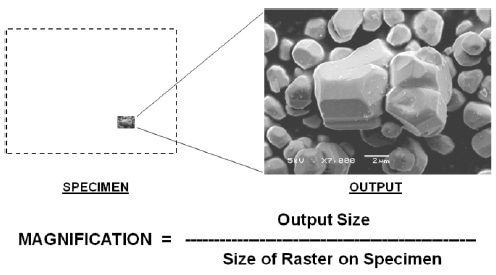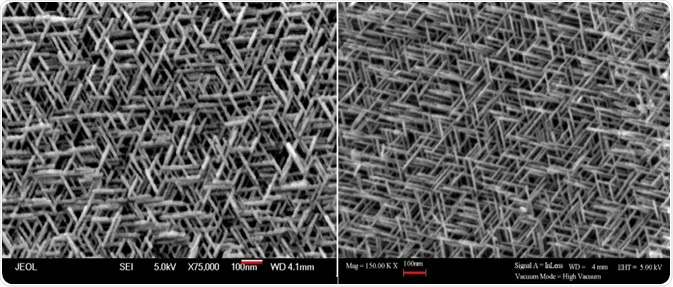Magnification is the term for the ratio between the size of the rastered area on the sample to the size of the rastered area of the output, as depicted in Figure 1. Historically, the output size was fixed as a Polaroid 4x5 film size by all manufacturers, which made it simple to compare results.
This ‘output size’ is now unclear as images are now captured through digital devices and can be output at a range of sizes. Manufacturers of SEM can select a range of output sizes for their images, which makes magnification a highly misleading number when SEM micrographs are compared from different SEM manufacturers.
For this reason, comparing the field of view or the length of the micron bar is the most effective way to compare images. Figure 2 illustrates this point by comparing the SEM images of hematite from two separate SEM manufacturers.
A JEOL SEM was used to acquire the left image which has a magnification labeled as 75,000 X with a 100 nm micron bar. The right image is sourced from a different SEM manufacturer which has a magnification labeled as 150,000 X with an identical length of a 100 nm scale bar (depicted in red).
This demonstrates that the sample enlargement is the same in both images, even though the value of magnification given by the different SEM manufacturer is double that of the JEOL image.

Figure 1. A small raster on the specimen leads to a large magnification for the same output size. Image Credit: JEOL USA, Inc.

Figure 2. SEM images of hematite with the same enlargement of the sample despite having different magnification values stated. Left image: From a JEOL SEM Right image: From a different SEM manufacturer. Image Credit: JEOL USA, Inc.

This information has been sourced, reviewed and adapted from materials provided by JEOL USA, Inc.
For more information on this source, please visit JEOL USA, Inc.